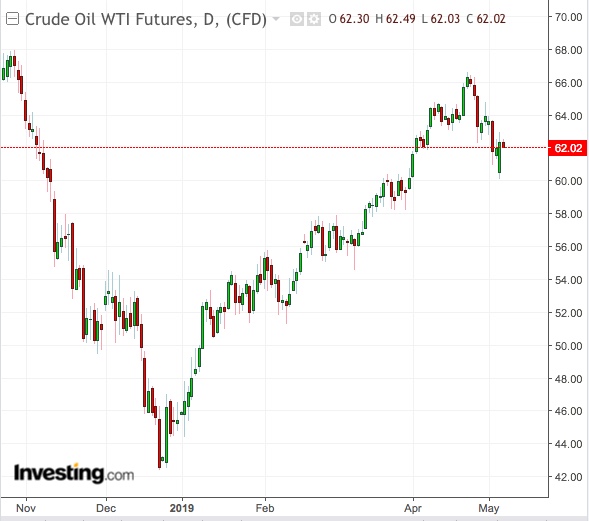What is oil’s endgame? Are we anywhere near one in the boom-bust-boom cycle of the past two years?
With relentless OPEC production cuts; more supply losses in Iran, Venezuela and Libya from either U.S. action or domestic unrest; an American naval carrier in the Gulf threatening to deal forcefully with Iranian strikes and finally the menace of fresh U.S. tariffs lurking over China, it’s interesting to see what answers those questions will bring.
More Supply Losses Likely
Bank of America Merrill-Lynch, making the same poser in its latest note on oil, says additional output losses cannot be ruled out. BofA’s conclusion is based on Saudi Arabia deliberately dragging out production increases in its new role as OPEC’s top price hawk, and the Trump administration doing its utmost to choke off crude exports by Tehran and Caracas to effect regime and other changes.
If an increasingly underserved market is what BofA anticipates, then the implication is that oil prices would also get a lot higher from where they are today.
And some market participants, like ICAP energy commentator and futures broker Scott Shelton, argue that the backwardation now in futures of U.S. West Texas Intermediate and U.K. Brent crude could be damaging to the market in the coming months if they get steeper.
Price Direction Could Be Mixed
Backwardation is a commodity futures’ dynamic where the spot or front-month contract trades at a premium to contracts farther out. This is great for financial investors who don’t take delivery of the commodity but just “roll” out of each expiring spot contract into the next front-month, selling the previous position at a premium and buying the new one at a discount to generate a gain.
But backwardation isn’t that great for the long-term optics of the commodity itself, given that prices look cheaper farther out the curve, especially if the differences are wide, like in the case of oil.The backwardation between December 2019 and December 2020 in Brent hit six-month highs in recent weeks.
Wrote Shelton in his oil note on Monday:
“Physical markets’ strength only works on flat price in a bull market. Now, the managed money world is in the middle of what appears to be a liquidation, in addition to the global equity markets being weak.”
“I would argue it makes the backwardation on Europe and Asia rally even more as the forward curve loses its bid when the equities are weak.”
BofA, in its own note on the so-called “endgame” in oil, also says the slow Saudi response to calls to raise production may exacerbate the backwardation in crude futures.

In its price analysis, BofA noted that oil prices were up more than 30% since their Q4 2018 crash, with front month Brent hitting $75 per barrel highs and WTI $67. But while spot prices have rallied more than $20 per barrel from the lows of December 2018, three-year prices have risen by a mere $6.
“On the downside, the coalition between Saudi (Arabia) and Russia will remain challenged by a different FX regime and oil industry structure,” it said, referring to the OPEC+ alliance on production cuts that has been trying for Moscow to remain in, despite political will at the top.
It said Iran's frail position might also make it difficult for OPEC to reach an outright consensus on production at its June meeting, particularly with Saudi Arabia in the tricky position of preserving the interests of all in the group despite its obvious enmity with Iran.
Economy, Presidential Tweets And U.S. Production As Potential Disrupters
BofA also suggested that the economy might pose problems.
“It is important to note that global oil demand growth is still decelerating despite the green shoots. Further global GDP weakness into year-end would hurt oil prices.”
Two other elements could stall the oil rally: U.S. President Donald Trump’s determination to keep domestic pump prices low in his bid for 2020 re-election, and the possibility of U.S. crude production continuing to make record highs.
Trump has so far been the most creative White House occupant in meddling with oil prices. On Sunday, the president tweeted that he intended to subject China to new tariffs on $200 billion worth of Chinese goods, after being annoyed by the slow progress in U.S.-Sino trade talks. The sum effect of those tweets on China was that they also dragged oil prices down by more than 2% in Monday’s early trade, before the market recovered on Gulf tensions.
Said Phil Flynn, senior energy analyst at The Price Futures Group in Chicago:
“You can’t beat the impact of a presidential tweet. Forget missiles flying in North Korea or missiles flying from terror groups into Israel. It’s all about the tweet. It’s the art of the deal or perhaps the art of the tweet. Trump tweeted that oil prices were too high, and they came down again.”
The coming months may see an increasing price battle between Trump and the Saudis, who raised the Official Selling Price of their Arab Heavy crude to Asian customers last week, in a bid to keep physical prices on par with the action in futures.
Trump is somewhat miffed with the Saudis for not ramping up production right after he decided not to allow any more sanction waivers to buyers of Iranian crude this month. His quest for low gasoline prices could make him a dangerous wild card to oil bulls, particularly as U.S. crude inventories start rising again.
Despite the record highs in U.S. crude production this year, U.S. drillers have been slow in adding barrels to their output. But BofA said this may not necessarily be the case for long.
“There is a risk that U.S. capital discipline does not lead to slower shale oil production growth.”
